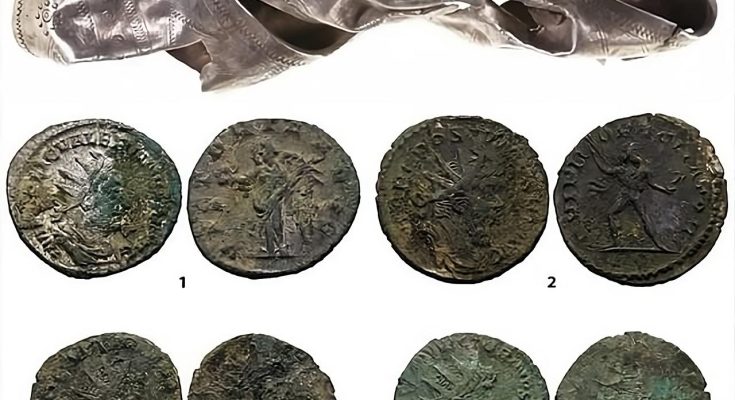The Remarkable Discovery
The hoard was discovered near the small town of Herschbach in the Westerwald mountain range, approximately 11 miles (18 kilometers) beyond the Upper Germanic Limes, which served as the Roman Empire’s northern frontier. The finder, a licensed metal detectorist, immediately reported the treasure to local archaeologists, setting off a meticulous excavation led by the State Archaeology Office in Rhineland-Palatinate.

The dig revealed approximately 2,940 coins buried in a broken ceramic pot hidden between two rocks. Alongside the coins, archaeologists unearthed over 200 thin silver fragments intricately decorated with geometric designs. These items, although fragmented, hinted at the artistic and cultural sophistication of the time. The remarkable preservation of the hoard, buried for nearly 1,800 years, was attributed to the protective nature of the ceramic pot and the stable conditions of the mountainous terrain.
Video:
The Coins and Artifacts
Types of Coins
Most of the coins belong to a category known as “Antoniniani,” which were initially silver coins but had, by the third century A.D., been largely reduced to bronze with a thin silver overlay. This debasement reflects the economic turmoil of the Roman Empire during this period.

The oldest coins in the hoard feature Emperor Gordianus III, who ruled between A.D. 238 and 244. The youngest coins depict Emperor Victorinus, a ruler of the short-lived Gallic Empire, who governed from A.D. 269 to 271. These dates suggest that the hoard was likely buried in the early 270s, during a time of great political and military instability in the Roman world.
Decorative Silver Fragments
In addition to the coins, the hoard contained over 200 silver fragments adorned with geometric patterns. These fragments might have been parts of larger decorative items, such as jewelry, ceremonial objects, or even high-value containers. While their exact purpose remains unclear, their craftsmanship provides valuable insights into the artistry and cultural practices of the era.

The Ceramic Pot
The coins and silver fragments were housed in a ceramic pot, which was consistent with Roman ceramic traditions of the third century A.D. The pot’s design, though broken, reflects Roman craftsmanship, indicating that it may have originated within the empire before being transported to its final resting place in the Westerwald mountains.

A Rare Find Outside Roman Borders
What makes this discovery particularly extraordinary is its location—well beyond the northern borders of the Roman Empire. While Roman coin hoards are commonly found within the empire’s territory, finding such a large collection outside its borders is exceedingly rare. Typically, hoards discovered in non-Roman lands consist of only a few dozen or perhaps a few hundred coins. This hoard, with nearly 3,000 coins, stands as one of the largest finds of its kind.
The Westerwald mountains, where the hoard was found, were not known to be a significant settlement area for either the Romans or the Germanic tribes of the time. This remote and isolated location raises intriguing questions: Why was the hoard buried here? Who placed it there? And what purpose did it serve?
Historical Context
The third century A.D. was a period of profound upheaval for the Roman Empire. Political instability, economic crises, and external pressures from barbarian tribes created a fragile and volatile environment. During this time, the Roman Empire fragmented, leading to the emergence of the Gallic Empire—a breakaway region that included modern-day France, Belgium, and parts of Germany.

Most of the coins in the hoard were minted in Cologne, a key city in the Gallic Empire. This suggests that the hoard may have been linked to the Gallic Empire’s activities, possibly as part of efforts to negotiate or bribe Germanic elites to maintain peace or encourage alliances. However, the exact circumstances surrounding the burial of the hoard remain speculative.



